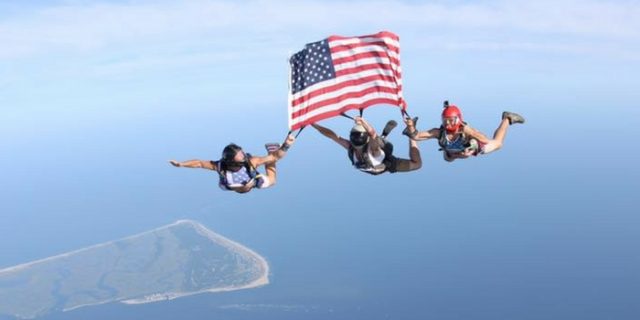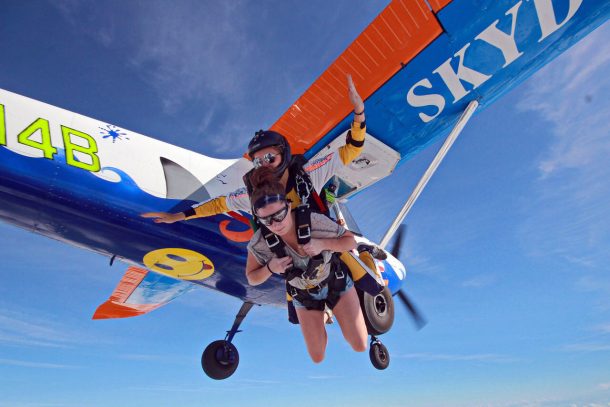How Was Skydiving Invented?
Skydiving Information
Posted by: SCC ADMIN
7 years ago

Have you ever wondered how people got started jumping out of airplanes?
Who decided it was a good idea, when did they do it, what happened and why? We explore skydiving history, from first parachute jump to the modern sport, here.
THE HISTORY OF SKYDIVING
The human desire to experience flight has existed since the dawn of time. The idea of leaving gravity behind to soar freely through the sky held back by nothing, has always been an appealing one.
As a sport, though, skydiving is relatively young. Though skydiving is widely popular in the US today, did you know it was actually military application that helped skydiving develop?
Of course, that’s not to say it’s all down to the military. Some pretty brave folks have dared to try out new parachute designs and ways of falling over the years! Back in the 1100s, the Chinese first tried the idea of jumping from a cliff or static object (known today as BASE jumping), but it wasn’t until much later that ‘skydiving’ in the modern sense came about.
WHO INVENTED SKYDIVING?
Leonardo da Vinci is most commonly credited with inventing skydiving, as far back in history as 1483.
The artist, known for his impeccable attention to detail, was also a curious scientist and his drawing of a triangular contraption designed to slow someone’s fall to a speed they could survive was technically the first ‘parachute’. Though later tests showed that had Leo ever dared to jump it, he may not have survived…
The first successful parachute jump was actually made by André-Jacques Garnerin from a hydrogen balloon, 3,200 feet above Paris, way back in 1797. Imagine being the first person to try that!
It was sometime between da Vinci’s sketch and the first skydive as we know it today. Credit for the first modern skydive from an airplane is split between Grant Morten and Albert Berry, with controversy rife to this day over who actually jumped first.
WHEN WAS TANDEM SKYDIVING INVENTED?
After the first pioneers took to the skies, more individuals decided to give skydiving a try too. Primarily, it was military application that made skydiving popular, with the army using parachutes to access difficult to get to places.
It was rare that a soldier would jump without some equipment or supplies, so the idea of jumping with weight attached was not a new one – even before tandem skydiving as we know it was invented. With proof in place that it was possible to jump with cargo, some people started to suggest that it could be possible to jump with a human passenger, too.
In the early 80s, tandem skydiving was still in ‘experimental’ status. This means it was being tested but had yet to be classified as a full sport. The FAA (Federation Aviation Administration) waived the experimental status, opening the door for tandem skydiving to grow in popularity. The United States Parachute Association (USPA) gave it sport status in the 1980s, making it possible for drop zones to offer tandem skydives to their customers.
Today, tandem skydiving is the most popular way to experience skydiving for the first time.
HOW HAS SKYDIVING EVOLVED?
The sport of skydiving today is very different to those early artist sketches and military applications.
The United States is home to the largest national skydiving competition in the world. Competitive skydiving has reached new highs – especially with new developments like skydiving simulators (or wind tunnels) making it even easier for athletes to hone their skills.
Tandem skydiving too has evolved, from being something considered ‘out there’ to something that features on most people’s bucket lists. Improving safety records have certainly helped with this, as has a changing perception of our sport as more people do it.
Perception and participation aren’t the only ways our sport has evolved, though. There have been massive leaps in technology and design that have really changed the way we jump.
Early skydivers used round parachutes, which were cumbersome and difficult to control. They basically deployed their chutes and kind of hoped they landed in the right place, only able to really pivot on a central point and not really fly to their intended spot in any way. Today, aerodynamics and engineering have made it possible for ‘square’ parachutes to become commonplace, offering a high degree of control, accuracy – and a lot more fun!
The invention of the three-ring release system in 1978 meant that it was much easier for skydivers to disconnect their main parachute if it failed to function and to deploy a secondary instead. This improved safety rates hugely! As did the invention of automatic activation devices (AADs) in 1989, meaning a parachute would be automatically deployed in the event the skydiver was for some reason unable to deploy for themselves at a safe altitude.
Skydiving has evolved so much over the years. But one thing remains consistent throughout history; it’s that wonder, that excitement, that incredible adrenaline rush you get as you soar through the sky that keeps people coming back!
Want to know how skydiving feels for yourself? Find out about tandem skydiving with us, or get in touch and we’d be happy to answer any questions.





